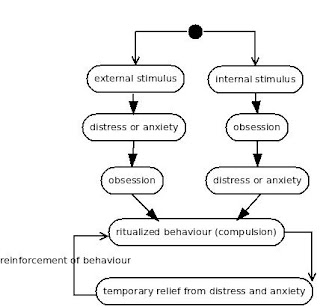As far as
we are concerned in this paper, we propose to classify Islamic Knowledge into
three categories:
1. Holy Quran,
2. Hadith,
3. Saying of renowned
Muslims.
In this
paper, we will focus, only on the prophet Muhammad (pbuh) sayings (hadiths), as
they provide us with important source of information, regarding our
methodology.
In the following section, we present a
new methodology for modeling hadiths, using what is called UML activity
diagram.
A. Activity Modelling for an activity hadith
In our
methodology, we present several basic rules:
1.
We decompose an activity (such as Salat), to
many different sub-activities (such as rakâa). For example :
2.
We decompose a sub-activity (such as rakâa), to
many different actions (such as takbir, reading, rokôo, soujoud, joulouss, etc...).
For example :
3.
We decompose an action, or activity, or
sub-activity into three components :
a. Condition (IF)
b. Result of the
condition (Then),
c.
Alternative Result (Else).
First, we
consider that a hadith that explains actions and activities of the prophet
Muhammad (pbuh). The following hadith is the perfect illustration of the
principle:
أنَّ فَهْدًا حَدَّثَنَا ، قَالَ : حَدَّثَنَا أَبُو غَسَّانَ ، قَالَ : حَدَّثَنَا زُهَيْرٌ ، قَالَ : حَدَّثَنَا أَبُو إِسْحَاقَ ، قَالَ : أَتَيْتُ الأَسْوَدَ بْنَ
يَزِيدَ ، وَكَانَ لِي أَخًا وَصَدِيقًا ، فَقُلْتُ يَا أَبَا عَمْرٍو ،
حَدِّثْنِي مَا حَدَّثَتْكَ عَائِشَةُ رَضِيَ اللَّهُ عَنْهَا أُمُّ
الْمُؤْمِنِينَ ، عَنْ صَلاةِ رَسُولِ اللَّهِ صَلَّى اللَّهُ عَلَيْهِ وَسَلَّمَ
، فَقَالَ : قَالَتْ : " كَانَ رَسُولُ اللَّهِ صَلَّى اللَّهُ عَلَيْهِ
وَسَلَّمَ يَنَامُ أَوَّلَ اللَّيْلِ وَيُحْيِي آخِرَهُ
، ثُمَّ إِنْ كَانَتْ لَهُ حَاجَةٌ قَضَى حَاجَتَهُ ، ثُمَّ يَنَامُ قَبْلَ أَنْ
يَمَسَّ مَاءً ، فَإِذَا كَانَ عِنْدَ النِّدَاءِ الأَوَّلِ ، وَثَبَ وَمَا
قَالَتْ قَامَ فَأَفَاضَ عَلَيْهِ الْمَاءَ ، وَمَا قَالَتْ : اغْتَسَلَ وَأَنَا
أَعْلَمُ مَا تُرِيدُ وَإِنْ كَانَ جُنُبًا تَوَضَّأَ وُضُوءَ الرَّجُلِ
لِلصَّلاةِ "
From:
First, we
have to separate the activity statements from the rest of the Islamic text:
كَانَ رَسُولُ اللَّهِ صَلَّى
اللَّهُ عَلَيْهِ وَسَلَّمَ يَنَامُ أَوَّلَ اللَّيْلِ وَيُحْيِي آخِرَهُ ، ثُمَّ
إِنْ كَانَتْ لَهُ حَاجَةٌ قَضَى حَاجَتَهُ ، ثُمَّ يَنَامُ قَبْلَ أَنْ يَمَسَّ
مَاءً ، فَإِذَا كَانَ عِنْدَ النِّدَاءِ الأَوَّلِ ، وَثَبَ وَمَا قَالَتْ
قَامَ فَأَفَاضَ عَلَيْهِ الْمَاءَ ، وَمَا قَالَتْ : اغْتَسَلَ وَأَنَا أَعْلَمُ
مَا تُرِيدُ وَإِنْ كَانَ جُنُبًا تَوَضَّأَ وُضُوءَ الرَّجُلِ لِلصَّلاةِ "
The highlighted
text represents a judgment of the narrator, and could help understand the
structure of the activities.
وَمَا قَالَتْ قَامَ فَأَفَاضَ عَلَيْهِ الْمَاءَ،
وَمَا قَالَتْ: اغْتَسَلَ وَأَنَا أَعْلَمُ مَا تُرِيدُ
In this
step, we try to differentiate between activity, sub-activities, and actions. For
ease of comprehension, we give the letter (A) for activities, the acronym (Sub)
for sub-activities, and the letter (a) for actions.
يَنَامُ أَوَّلَ اللَّيْلِ
|
Action
|
وَيُحْيِي آخِرَهُ
|
Activity
|
ثُمَّ إِنْ كَانَتْ لَهُ حَاجَةٌ
|
If condition
|
قَضَى حَاجَتَهُ
|
Then action
|
ثُمَّ يَنَام
|
Action
|
قَبْلَ أَنْ يَمَسَّ مَاءً
|
Condition (and action)
|
فَإِذَا كَانَ عِنْدَ النِّدَاءِ
الأَوَّلِ
|
If condition
|
وَثَبَ
|
Then action
|
وَإِنْ كَانَ جُنُبًا
|
If condition
|
تَوَضَّأَ وُضُوءَ الرَّجُلِ لِلصَّلاةِ
|
Then Activity
|
For
computer scientist, this structure is very likely an algorithm, which could be
encoded in computer understandable language, please refer to discussions at the
end of the paper.
B. UML Activity Modelling for an activity hadith
Since the
previous hadith focused on actions and activities, we choose to call it
“activity hadith”. In consequence it should be modelled by a tool providing
such possibilities; we present hereafter an example of hadith’s modelling using
UML activity diagram.





